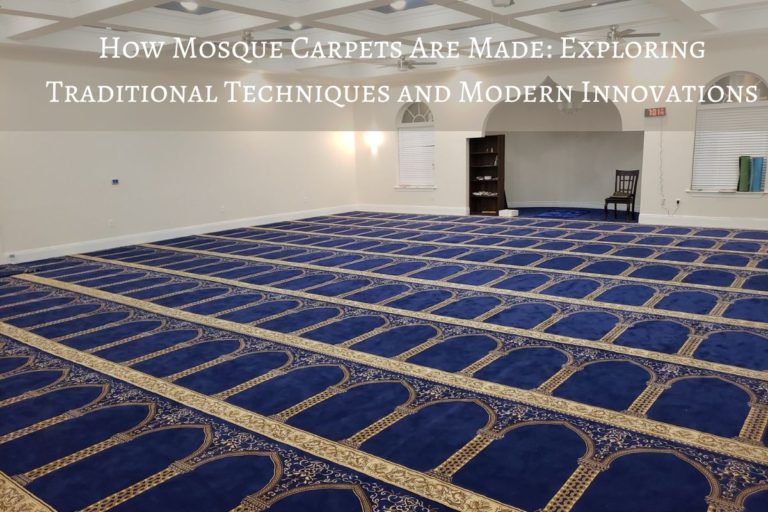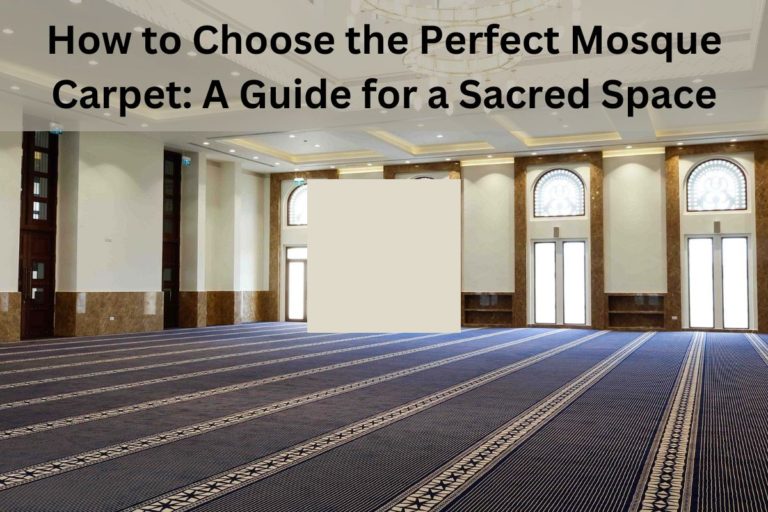Mosque carpets are more than mere floor coverings; they embody the rich history, artistry, and spirituality inherent in Islamic worship. These carpets play a vital role in creating a sacred atmosphere where individuals come together to pray and reflect. Crafted from various materials and employing intricate techniques, mosque carpets reflect regional traditions and cultural influences, each telling a unique story. From the lush textures of hand-knotted wool to the vibrant colors of modern designs, every carpet serves a purpose, enhancing the aesthetic and spiritual experience within the mosque. In this exploration, we delve into the materials, craftsmanship, and cultural significance behind these sacred artifacts, highlighting their essential role in the spaces where faith thrives.
From Tradition to Today: The Historical Role of Carpets in Mosques
Mosque carpets have a rich history that intertwines with Islamic culture. Historically, these carpets served not only as functional floor coverings but also as expressions of artistic and spiritual identity. They date back to the early days of Islam, where carpets were used in mosques to create a comfortable space for prayer and community gatherings. Over the centuries, the designs and materials used have evolved, reflecting regional styles and cultural influences. Today, mosque carpets are not only seen as utilitarian objects but as intricate works of art that embody the spiritual essence of Islamic worship.
The Tapestry of Tradition: Exploring the Diverse Materials of Mosque Carpets
Mosque carpets are crafted from various materials, each offering unique qualities. Natural fibers like wool are commonly used due to their durability, warmth, and luxurious feel. Silk adds a touch of elegance, often used in high-end carpets for its sheen and intricate designs. Cotton provides affordability and easy maintenance, while jute is appreciated for its eco-friendliness. In modern carpets, synthetic fibers such as nylon and polyester are increasingly popular for their resistance to wear and moisture. These materials ensure that mosque carpets remain functional while also enhancing the aesthetic appeal of sacred spaces.
From Loom to Legacy: The Techniques of Mosque Carpet Craftsmanship
The craftsmanship behind mosque carpets is a blend of art and tradition. Hand-knotting is a traditional technique that involves skilled artisans meticulously tying knots to create intricate designs. This method allows for detailed patterns and textures, making each carpet unique. Machine weaving has become more common, enabling faster production while maintaining quality. Various techniques, such as flatweaving, are used to create different textures and styles. Design patterns often feature geometric shapes, floral motifs, and Arabic calligraphy, all symbolizing elements of faith. The craftsmanship ensures that each carpet is not just a floor covering but a testament to cultural heritage.
Cultural Tapestry: The Diverse Styles of Mosque Carpets Around the World
Mosque carpets reflect the diverse cultural influences of the regions in which they are made. In the Middle East, carpets often feature intricate geometric designs and rich colors, drawing from centuries of artistic tradition. South Asian mosque carpets may incorporate floral patterns and vibrant hues, influenced by local textile arts. North African carpets, known for their bold designs, often symbolize tribal heritage. Each style carries its own significance, showcasing the region’s history and craftsmanship. These cultural variations enrich the worship experience, creating a unique ambiance in every mosque and connecting congregants to their heritage.
Strength Meets Serenity: The Practical Aspects of Mosque Carpets
Functionality and durability are paramount in mosque carpets, as they must withstand heavy foot traffic during daily prayers and special events. High-quality materials are essential for ensuring that carpets resist wear, fading, and staining. Many carpets are designed with low pile heights, facilitating easier cleaning and maintenance while providing comfort during prolonged prayer sessions. Additionally, carpets are often treated with stain-resistant coatings to maintain their appearance. The combination of durability and functionality ensures that mosque carpets not only enhance the aesthetic of sacred spaces but also serve practical purposes for worshippers.
Weaving Faith: The Spiritual Significance of Mosque Carpets
The symbolism of mosque carpets extends beyond their aesthetic appeal; they play a crucial role in enhancing the spiritual experience. Carpets create a defined, sacred space for prayer, helping worshippers focus and connect with their faith. The intricate designs often reflect Islamic teachings, with geometric patterns symbolizing unity and infinity. Calligraphic motifs can represent verses from the Quran, reinforcing the spiritual significance of the space. The act of prayer on these carpets fosters a sense of humility and reverence, contributing to the overall ambiance of the mosque and enriching the worship experience for congregants.
Sustainable Weavings: The Ethical Journey of Mosque Carpets
Sustainability is increasingly important in the production of mosque carpets. Many manufacturers are now focusing on eco-friendly materials and ethical practices, such as using organic fibers and dyes that have minimal environmental impact. Supporting local artisans and communities ensures fair trade practices and helps preserve traditional craftsmanship. By sourcing materials responsibly and promoting sustainable production methods, the carpet industry contributes to environmental conservation. This approach not only benefits the planet but also enriches the cultural significance of mosque carpets, as they become symbols of sustainable practices within the sacred spaces they adorn.
Installation and Maintenance
Proper installation and maintenance are essential for preserving the beauty and longevity of mosque carpets. Professional installation ensures that carpets are laid correctly, avoiding wrinkles or misalignments that could affect their appearance. Regular cleaning is vital, as high foot traffic can lead to dirt accumulation. Vacuuming frequently and using gentle cleaning solutions can help maintain the carpet’s condition. Additionally, periodic professional cleaning can extend the lifespan of the carpets. Educating mosque administrators and congregants about proper care ensures that these beautiful pieces of art remain vibrant and functional for years to come.
Case Studies or Examples
Notable mosques around the world are renowned for their exquisite carpets, each telling a story of craftsmanship and faith. The Sheikh Zayed Grand Mosque in Abu Dhabi features one of the largest handmade carpets globally, designed with intricate floral motifs and symbols. The Blue Mosque in Istanbul showcases stunning carpets that complement its iconic blue tiles. Additionally, the Faisal Mosque in Islamabad boasts carpets reflecting traditional Pakistani designs. These examples highlight the importance of carpets in enhancing the architectural beauty of mosques while serving as focal points of cultural and spiritual significance.
Conclusion
In conclusion, mosque carpets represent a blend of history, artistry, and spirituality. They are not merely decorative elements but essential components that enhance the worship experience. Through various materials, craftsmanship techniques, and cultural influences, these carpets create a sacred atmosphere that fosters connection and reflection. Emphasizing sustainability and ethical practices further enriches their significance, ensuring that future generations can appreciate the beauty and importance of mosque carpets. By understanding and valuing these aspects, we honor the rich heritage and spiritual essence that carpets bring to sacred spaces.






